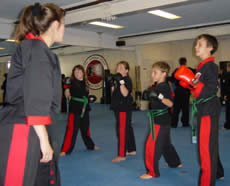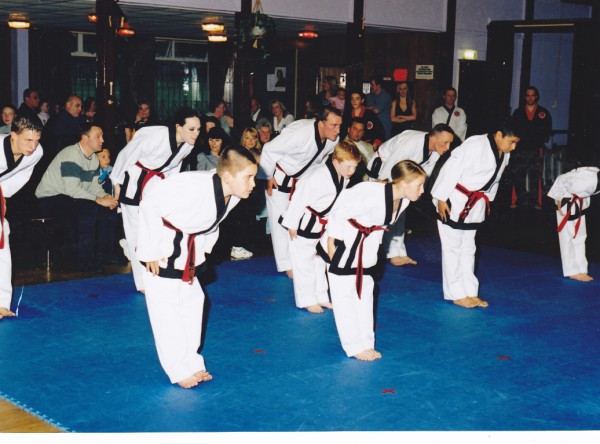Why do You Teach Taekwondo to Children?
Have you ever asked yourself the question, ‘Why do I teach children?’ Answer the question carefully, because if it is not in your heart or disposition to teach kids, then you shouldn’t be doing it at all… Have you ever sat back and reflected, ‘What do I teach and how am I teaching? Are the children actually learning something valuable? Martial arts is a fantastic medium to develop a child’s ability to focus, concentrate, particularly if an instructor has the ability to make the material exciting and fun, therefore interesting. The drills in class teach cooperation, respect, confidence and can help, in conjunction with school, to instill life-long health and exercise habits. In other words, martial arts is an excellent medium to provide ‘Martial Arts Education’ as well as promoting the physical exercise as a lifelong agenda. Within the Republic of Ireland, there are currently only a few professional martial arts schools. The majority of clubs are non-professional, led by larger organizations, operating in schools, sports centers and community halls. Despite the many claims the martial arts appears to provide, there are many flaws in teaching methods and curricula, particularly where children are concerned, which are a result of holding on excessively to the ‘Traditional’ ways and failing to take into account that children are not adults. Therefore instructors may not innovate in their practices.
- Where do we experience innovation in martial arts?
 Within the martial arts, it is found that innovation is generally experienced in professional full time schools. This is because these schools rely on retention of students for income and therefore school owners strive to do everything to improve the quality, enjoyment and value of their tuition practices for their students. Many martial artists may object to these methods, or the curricula these schools may teach, but, if they are teaching valuable lessons in life to children, engaging them in physical exercise, is this not a good thing? This concept would make an interesting thought provoking exercise for non-professional martial artist, by asking the question, ‘How would you change your practice if your total income relied on the number of children who wanted to attend their classes?’ Of course, there are many dedicated non-professionals who do great work for the community, and this is to be commended. But for those of you who experience regular drop off, you may need to sit down and consider that you may be doing something slightly wrong when it comes to teaching children.
Within the martial arts, it is found that innovation is generally experienced in professional full time schools. This is because these schools rely on retention of students for income and therefore school owners strive to do everything to improve the quality, enjoyment and value of their tuition practices for their students. Many martial artists may object to these methods, or the curricula these schools may teach, but, if they are teaching valuable lessons in life to children, engaging them in physical exercise, is this not a good thing? This concept would make an interesting thought provoking exercise for non-professional martial artist, by asking the question, ‘How would you change your practice if your total income relied on the number of children who wanted to attend their classes?’ Of course, there are many dedicated non-professionals who do great work for the community, and this is to be commended. But for those of you who experience regular drop off, you may need to sit down and consider that you may be doing something slightly wrong when it comes to teaching children.
First of all, consider the history of many traditional martial arts. Many originate from a historical background of oppression, devastation and war. They were hence designed for males in a military environment. Martial arts have been passed onto civilian men, women and children with steadfast obedience to the original forms, hence the terminology “Traditional”. It was no wonder there few women and children practiced in the 60’s and 70’s when it was first introduced to the west. As it stands, changes may have been made to a certain extent but, in many cases, much has been kept the same. Teaching practices, continue to be very formal, dictatorial and over-structured, handed down from generations of instructors, many of which are a little too rigid or inflexible when teaching young children is concerned. The result is that only a few children engage in lifelong learning as a high proportion will drop out before gaining any real benefits.
- Politics and Power and Change
Many instructors feel they are unable to change in their practices because of restrictions from their organisations. I urge you to consider the child before the organisation, question deeply your practices, are they aligned with your personal values or of those of a hierarchical organization which often is behind with the times.
- Comparing the Traditional curriculum with an innovative martial arts curriculum and teaching practices.
 J.Graden (1998, p.25) explained that a traditional curriculum would normally overwhelm a beginner student, often being confusing, difficult and frustrating and will bore a more advanced student because most of the material is generally taught , in a concentrated fashion, within the first two years of training. Much of the material fails to live up to the expectations of the students. For example, if the student has joined to learn self-defence and get fit, many of the traditional exercises actually have very little relevance in these areas and progress can be quite static. As the emphasis of a traditional curriculum would be very much on skill and performance, the martial arts instructors have a tendency to be overcritical, correcting every single mistake so that the student ends up feeling demoralized rather than boosted with self-confidence. It also requires the student to remember a series of complex moves and the names of the moves perhaps in Korean or Japanese. For a child, this is completely daunting. In comparison, an innovative approach within the martial arts, especially concerning children, is the ‘Minimalist curriculum’ (T.Callos August 2000). The quantity of material a child is expected to remember would be less, expectations of technical ability, especially in the first year of training should be less as it is all they can cope with at that stage of their development. The programme should ‘evolve’ and educate the child. Tom Callos said, ‘My goal is to live and work in a world… where science, literature, and art are a million times more valuable than a kick or a punch’ (Callos Sept 2000, p.40). This is what he referred to as ‘Martial Arts Education’ (p.40) . Physically, the student is expected to learn only a few basic, useful moves, using the English language, and then enjoy practicing them in a series of creative drills or games, without too much emphasis on achieving perfection. The philosophy is ‘Less is more’. Innovative Taekwondo curriculum is skillfully simplistic, yet will not compromise on workout. If anything, the simplification allows for more activity to be done over a period of time. J.Graden (1998, p.18) talks about the beginner being focussed about ‘Learning Black Belt Attitude’, that is ‘building the student’s enthusiasm for the martial arts, for his school and for earning a black belt’ (p.18). In effect, this could be translated into ‘building enthusiasm for lifelong learning’. Graden also talks about getting students to ‘learn how to learn’, ‘to try without getting discouraged’ and to learn how to connect these principles beyond the classroom, into their everyday lives. In this way they are participating in life long learning and will continue to have enthusiasm to train long-term.
J.Graden (1998, p.25) explained that a traditional curriculum would normally overwhelm a beginner student, often being confusing, difficult and frustrating and will bore a more advanced student because most of the material is generally taught , in a concentrated fashion, within the first two years of training. Much of the material fails to live up to the expectations of the students. For example, if the student has joined to learn self-defence and get fit, many of the traditional exercises actually have very little relevance in these areas and progress can be quite static. As the emphasis of a traditional curriculum would be very much on skill and performance, the martial arts instructors have a tendency to be overcritical, correcting every single mistake so that the student ends up feeling demoralized rather than boosted with self-confidence. It also requires the student to remember a series of complex moves and the names of the moves perhaps in Korean or Japanese. For a child, this is completely daunting. In comparison, an innovative approach within the martial arts, especially concerning children, is the ‘Minimalist curriculum’ (T.Callos August 2000). The quantity of material a child is expected to remember would be less, expectations of technical ability, especially in the first year of training should be less as it is all they can cope with at that stage of their development. The programme should ‘evolve’ and educate the child. Tom Callos said, ‘My goal is to live and work in a world… where science, literature, and art are a million times more valuable than a kick or a punch’ (Callos Sept 2000, p.40). This is what he referred to as ‘Martial Arts Education’ (p.40) . Physically, the student is expected to learn only a few basic, useful moves, using the English language, and then enjoy practicing them in a series of creative drills or games, without too much emphasis on achieving perfection. The philosophy is ‘Less is more’. Innovative Taekwondo curriculum is skillfully simplistic, yet will not compromise on workout. If anything, the simplification allows for more activity to be done over a period of time. J.Graden (1998, p.18) talks about the beginner being focussed about ‘Learning Black Belt Attitude’, that is ‘building the student’s enthusiasm for the martial arts, for his school and for earning a black belt’ (p.18). In effect, this could be translated into ‘building enthusiasm for lifelong learning’. Graden also talks about getting students to ‘learn how to learn’, ‘to try without getting discouraged’ and to learn how to connect these principles beyond the classroom, into their everyday lives. In this way they are participating in life long learning and will continue to have enthusiasm to train long-term.
References:
Callos, T (2000): Evolution and Education: Universal tools for the Martial Arts. Martial Arts Professional, September 2000, p.40
Callos, T (2000): Random thoughts on the Martial Arts from my Notebook. Martial Arts Professional, August 2000, p.40
Graden, J. (1998): ACMA Instructor Certification Manual, Chapters 2 & 3




